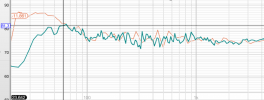In other forums on this site I have commented extensively on the value and meaning of room measurements and "correction". I published a paper, which you can freely access that explains some of it: Toole, F. E. (
2015). “The Measurement and Calibration of Sound Reproducing Systems”, J. Audio Eng. Soc., vol. 63, pp.512-541. This is an open-access paper available to non-members at
www.aes.org http://www.aes.org/e-lib/browse.cfm?elib=17839. "House curve" is a term used in pro audio in days when steady-state measurements were all that could be done and it was assumed that each venue had an "ideal" curve. It was wrong but the term still lingers. The direct sound is what matters most as a starting point in venues of any size. Once the sound has been launched into a reflective space - any normal room - it is not possible to interrogate the detailed performance of a loudspeaker from measurements at the listening location. Comprehensive anechoic data are essential to understanding what a "room curve" is showing. This is usually absent, so there develop endless discussions of "optimum" room curves.
In brief, I used REW, a free downloadable measurement program, and a single calibrated mic located at 2 m on axis to evaluate and correct the direct sound - which the "automatic calibration" had seriously altered. This is an essential factor to get right. This was confirmed at the listening location with a small spatial average to assess the bass performance and to finess the EQ of the four subwoofer "Sound Field Management" scheme I used (described in Section 8.2.8 in the 3rd edition).







